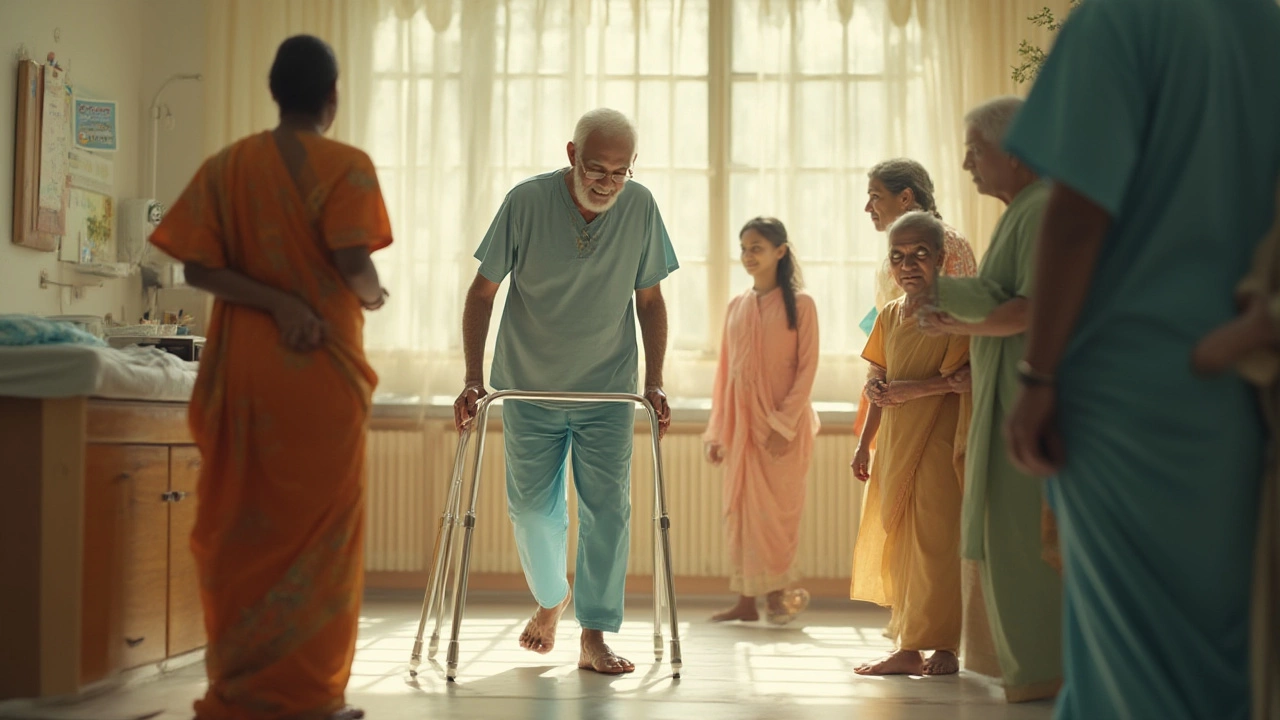
- Jul, 8 2025
- 0
The idea of walking after a total knee replacement sparks equal parts hope and anxiety. You’ve probably heard everything from “you’ll be strolling in days” to “expect months before you’re mobile”. So who’s right? It’s not one-size-fits-all. The real answer is more surprising, and it’s not just about healing bones or waiting for swelling to go down—it’s about your attitude, your daily choices, and but also the skill of your surgical team.
What Happens During a Total Knee Replacement?
Let’s clear something up first: during total knee replacement, the surgeon doesn’t just swap your knee for a bionic one like something out of a sci-fi movie. Instead, they trim the damaged bone and cartilage, then put in a metal and plastic joint. The whole thing takes about 1-2 hours, and you’ll be under anesthesia the whole time. Surgeons around the world perform more than 1 million knee replacements every year—one of the most common orthopedic surgeries.
The new knee is designed to mimic the movement of your natural joint, but it’s not as forgiving. Imagine trading your old, creaky hinge for a new, firmly oiled one—it still needs time to settle in. Surgeons use a cocktail of medications to keep pain controlled. In most hospitals, you’ll be encouraged, or sometimes practically dragged out of bed, to stand up and even take a few steps within one day after surgery. Crazy, right? But early movement isn’t just a pep talk—it really helps speed up how quickly you get your stride back.
What you don’t see on the highlight reels: the swelling, the muscle soreness, the emotional rollercoaster that comes with seeing your leg covered in stitches. But all that early effort pays off big time for your outcome.
When Will You Walk, Step-By-Step Timeline
So, how soon can you expect to walk? Well, here’s a more realistic, week-by-week breakdown:
- Day 1-2: Physical therapists visit your bed. Most people stand and walk a few steps (with a walker) within 24 hours. Yes, this fast. Studies show early movement lowers blood clots and speeds up overall recovery.
- Days 3-5: Walking short distances, usually with a walker or crutches. Maybe from your hospital room to the bathroom. The pain’s there, but so are strong meds. Nurses cheer you on. The main challenge is stiffness and feeling awkward about moving the new joint.
- Week 1: If you’re healing well, you leave the hospital. At home, you keep walking short distances several times a day—even just up and down your hallway counts. You’ll have home visits from a physiotherapist, who’ll nag you about heel slides, leg lifts, or getting out of chairs safely.
- Week 2-4: Some people can ditch the walker for a cane. Each week, you’ll notice you’re limping less and moving faster. You might be able to go up and down a short flight of stairs, though likely one step at a time.
- Months 1-2: Now we’re getting somewhere. It’s not unusual to walk several blocks with a cane, or even unaided for some. Some people say they forget about the knee during short walks around the house. But try to run or pivot quickly, and you’ll quickly remember the limits.
- 3+ months: Most daily activities are back within reach. Golf, doubles tennis, hiking—those might take longer or may need to wait until the knee feels truly solid, which can mean 6-12 months for some folks. Long story short: you’ll usually walk again day one, but getting your old swagger back is a marathon, not a sprint.
Here’s a look at a standard recovery timeline from recent hospital data:
| Milestone | Average Time to Achieve |
|---|---|
| First Steps with Assistance | 1 Day |
| Walking Independently Indoors | 2-4 Weeks |
| Walking Outdoors/Longer Distances | 5-8 Weeks |
| Climbing Stairs Normally | 6-12 Weeks |
| Return to High-Impact Sports | 6-12 Months |

What Really Speeds Up Knee Replacement Recovery?
Now to the burning question: what actually makes a difference in getting you back on your feet after total knee replacement? Honestly, it’s the stuff you do—the hard, boring, repetitive work. The surgeons have done their job; now it’s your turn. Here’s what makes the biggest splash:
- Follow those exercise routines. Physical therapists design them for a reason, even though they’re no fun. Consistent exercise helps prevent scar tissue and builds muscle, which is crucial for regaining mobility.
- Pain management isn’t just about comfort. If you try to tough out the pain, you’ll move less, which slows healing. Tell your doctors if pain is getting in the way of movement—they can tweak your meds or recommend ice, elevation, and other tricks.
- Get moving early, but don’t overdo it. Going for a marathon walk right off the bat can hurt healing. Small and frequent walks help more. Sitting or lying around for hours on end just makes the knee stiffer.
- Balance rest and motion. Too much time on the couch can tighten up your knee, but skipping rest just leads to swelling and setbacks. A rhythm of exercise, movement, and mindful downtime is key.
- Keep expectations realistic. No one does jumping jacks at week two. There will be plateaus—some days you’ll feel set back, but the timeline isn’t linear. Progress can jump quickly after plateaus, and that’s totally normal.
By the way, according to recent hospital surveys, people who stick to their physiotherapy plan walk unaided almost two weeks earlier than those who skip out. That’s a statistical edge you can’t ignore.
Common Roadblocks and How to Handle Them
If walking after surgery feels hard, you’re not broken—you’re human. Most people hit a few speed bumps:
- Swelling is the main villain the first few weeks. Keeping your leg elevated above heart level and regular icing knocks back swelling considerably. Some swelling can linger for months, but that’s par for the course.
- Muscle stiffness and that weird “brick-like” feeling in the new knee is normal. The urge to avoid bending can be huge, but stretching (even when it feels tight) will pay off in the long run. Some people massage their thighs or use gentle heating pads to loosen stubborn muscles.
- Limping usually fades after the first month, but only if you focus on walking with a normal pattern (heel down first, roll to the toes).
- Fatigue is sneakier than you think. Your body’s using tons of energy to heal and new nerves are still rebooting. Nap if tired, but get up regularly—even short walks to the kitchen count.
Sometimes you’ll hear creaks, pops, even clicks from the new joint. Most of that’s harmless: just your leg getting used to new hardware. But severe pain, redness, major swelling, or any fever should trigger a call to your surgeon—rare, but better safe than sorry.

Tips for Walking Again After Knee Replacement
When it comes to getting back on your feet, the details add up. Here are some practical, real-life tips (straight from folks who’ve been through it):
- Have a stable chair or countertop nearby when you first stand or walk (for balance control).
- Use shoes with grippy soles instead of slippers—they give better stability on slick floors.
- Walk short distances often rather than longer walks that leave you wiped out. Ten mini-walks beat two exhausting hauls down the hall.
- Ice your knee after exercise or longer walks—it shrinks swelling and helps with pain control.
- Don’t be shy about using a walker or cane, even if you think you don’t need it. They prevent falls and give you confidence early on.
- Track your steps or progress (there are plenty of free apps for this). Seeing numbers rise each day can motivate you on tough days.
- Stay hydrated and eat protein-rich foods. Your body needs those building blocks for muscle and tissue healing.
- Ask your doc before trying uneven terrain, jogging, or any sport. Certain moves (like high-impact jumps) are best avoided—those new knees are tough, but not invincible.
Take it from people who have gone through it: the first walk feels weird, almost wobbly. The second walk, a little easier. Suddenly, one day, you realize you’ve walked from the kitchen to the front door—and forgot about the knee altogether. It’s never instant, but progress stacks up faster than you’d guess.
If you’re lining up for surgery or already staring at a scar, remember: you won’t just walk again—you’ll probably move better than before. Every day post-surgery, you’re one step closer to leaving pain behind and really moving with that brand new knee.
Nikhil Verma
I'm a dedicated physician with a passion for exploring the intricacies of medicine, focusing on the unique healthcare challenges in India. I spend much of my spare time writing articles aimed at improving public understanding of health issues. Balancing my clinical practice and writing allows me to reach a wider audience, sharing insights and fostering a deeper appreciation for medical advancements. I derive immense satisfaction from both treating patients and engaging with readers through my writing.